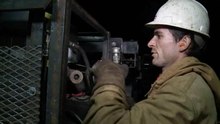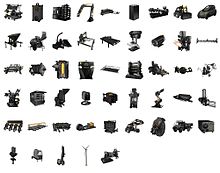 | |
| Abbreviation | OSE |
|---|---|
| Formation | 2003 |
| Headquarters | Factor e Farm |
| Location |
|
Region served
| Worldwide |
ED
| Marcin Jakubowski |
Budget
| $4,000 monthly |
| Website | Opensourceecology.org |
Open Source Ecology: Practical post scarcity
The 50 machines that compose the Global Village Construction Set
Open Source Ecology (OSE) is a network of farmers, engineers, architects and supporters, whose main goal is the eventual manufacturing of the Global Village Construction Set (GVCS).
As described by Open Source Ecology "the GVCS is an open technological
platform that allows for the easy fabrication of the 50 types of
industrial machines that it takes to build a small civilization with
modern comforts". Groups in Oberlin, Ohio, Pennsylvania, New York and California are developing blueprints, and building prototypes in order to pass them on to Missouri. The devices are built and tested on the Factor e Farm in rural Missouri. Recently, 3D-Print reports OSE has been experimenting with RepRap 3-D printers as suggested by academics for sustainable development.
History
Marcin Jakubowski founded the group in 2003. In the final year of his doctoral thesis at the University of Wisconsin,
he felt that his work was too closed off from the world's problems, and
he wanted to go a different way. After graduation, he devoted himself
entirely to OSE.
OSE made it to the world stage in 2011 when Jakubowski presented his Global Village Construction Set TED Talk. Soon, the GVCS won Make magazine's Green Project Contest. The Internet blogs Gizmodo and Grist produced detailed features on OSE. Jakubowski has since become a Shuttleworth Foundation Fellow (2012) and TED Senior Fellow (2012).
In December 2013, Marcin married Catarina Mota. She co-chaired
the Open Hardware Summit 2012, served on the board of directors of the
Open Source Hardware Association, taught as an adjunct faculty member at
ITP-NYU, and was a fellow of the National Science and Technology
Foundation of Portugal.
Catarina finished her PhD dissertation on the social impact of
open and collaborative practices for the development of physical goods
and technologies. She was a visiting scholar at ITP-NYU, Research Chair
at the Open Source Hardware Association, TED Fellow, and member of NYC
Resistor.
Open Source Ecology is also developing in Europe as OSE Europe.
In 2016, OSE and the Open Building Institute joined forces to
make affordable, ecological housing widely accessible.< The
initiative has prototyped the Seed Eco-Home – a 1400 square foot home
with the help of 50 people in a 5-day period – demonstrating that OSE's Extreme Manufacturing
techniques can be apply to rapid swarm builds of large structures.
Materials for the Seed Eco-Home cost around US$30,000. Further, OBI has
prototyped the Aquaponic Greenhouse – which was also built in 5 days
with 50 people.
Factor e Farm
The Factor e Farm
is the headquarters where the machines are prototyped and tested. The
farm also serves as a prototype. Using the Open Source Ecology
principles, Marcin and Catarina have built four prototype modules which
comprise their home. An added greenhouse demonstrates how a family can
grow vegetables and fish. Outside, there is also a large garden
including fruit trees.
Current progress
In 2020, OSE is planning its most ambitious collaborative design effort by hosting an Incentive Challenge on the HeroX platform
- to produce a professional grade, open source, 3D printed cordless
drill that can be manufactured in distributed locations around the
world. This project is intended to provide a proof-of-concept for the
efficiency of open source development applied to hardware - in addition
to its proven success with software.
In 2019, OSE began running its Open Source Microfactory STEAM Camps.
In 2018, the project achieved 33% completion.
In 2014, 12 of the 50 machines were designed, blueprinted, and prototyped, with four of those reaching the documentation stage.
On October 2011 a Kickstarter fundraising campaign collected US$63,573 for project expenses and the construction of a training facility. The project has been funded by the Shuttleworth Foundation and is a semifinalist in the Focus Forward Film Festival.
- Powercube v7 Assembly video
- Liberator Compressed Earth Brick Press v4 Assembly video
Awards and recognition
- From 2012 to 2014, Dr. Jakubowski was awarded a Shuttleworth Foundation Fellowship.
- In 2011, the project won the Green Project Contest organized by Make magazine.
- It was one of the 21 semi-finalists for the Buckminster Fuller Challenge, among 162 participants.
- TIME magazine rated OSE's Civilization Starter Kit as a top invention of the year 2012.
List of machines
The Global Village Construction Set (GVCS) comprises 50 industrial machines:
| Category | Global Village Construction Set (GVCS) |
|---|---|
| Habitat |
Compressed earth block press v4 · Concrete mixer · Sawmill · Bulldozer · Backhoe
|
| Agriculture |
Tractor: LifeTrac v3 · Seeder · Hay rake · Microtractor · Rototiller · Spader · Hay cutter · Trencher · Bakery oven · Dairy milking machine · Microcombine harvester · Baler · Well-drilling rig
|
| Industry |
Multimachine · Ironworker · Laser cutter · Welder · Plasma cutter · Induction furnace · CNC torch table · Metal roller · Wire and rod mill · Press forge · Universal rotor · Drill press · 3D printer · 3D scanner · CNC circuit mill · Industrial robot · Woodchipper / Hammermill
|
| Energy |
Power Cube: PowerCube v7 · Gasifier burner · Solar concentrator · Electric motor / generator · Hydraulic motor · Nickel–iron battery · Steam engine · Steam generator · Wind turbine · Pelletizer · Universal power supply
|
| Materials |
Aluminium extractor · Bioplastic extruder
|
| Transportation |
Car · Truck
|
GVCS replication
The
first time the Global Village Construction Set product was created by
another group was in October, 2011; Jason Smith with James Slade and his
organization Creation Flame developed a functioning open source CEB press. A group in Baltimore, Maryland, and a group in Dallas, Texas also began manufacturing GVCS machines.







